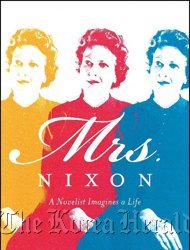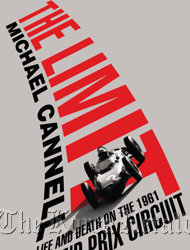Grafton has another choice letter
V Is for Vengeance
By Sue Grafton
(Marian Wood Book/G.P. Putnam’s Sons)

“V Is for Vengeance,” and it’s also for very, very good.
With just a few letters remaining in Sue Grafton’s alphabet series of mysteries, the author has hit a high mark with her latest offering, a complex tale of love, betrayal, ambition and, of course, murder.
“V Is for Vengeance” begins with Kinsey Millhone nursing a broken nose (and two black eyes) that she got from poking it into other people’s business.
The hardworking private detective was shopping in the lingerie section of a department store when she spotted a pair of women who were shoplifting, and they were making quite a haul: a lacy teddy here, a pair of silk pajamas there. But Kinsey, a former cop, wasn’t about to let them get away with it. She reported them to the salesclerk. Security was called. One woman was arrested, the other one got away.
Kinsey is shocked when the woman who was arrested later turns up dead, apparently a suicide. Then the dead woman’s fiancé shows up and asks Kinsey to investigate, saying there is no way the happy woman he knew would have been shoplifting, and certainly no way she would have killed herself.
Grafton has been following Kinsey’s cases since “A Is for Alibi.” But the years haven’t hurt her heroine. In this latest book, it’s 1988 and she’s celebrating her 38th birthday, still single, still in love with her 88-year-old landlord and still enjoying bad meals and bad wine at Rosie’s.
She’s not much older, but she is much wiser, especially after her latest case.
The same could be said for Grafton, who presents a variety of well-developed, interesting characters and several points of view, not just Kinsey’s. It’s a further step in what Grafton started in “U Is for Undertow.”
As Kinsey wanders among old friends, old enemies, old flames and some old memories, readers also get to see the thinking of some of the other characters as she tries to sort out twisted leads -- and they try to sort out tangled emotions. For such a string of very disreputable characters -- a petty thief, a corrupt cop, a member of the mob and a woman wronged -- many turn out to be sympathetic.
Although Grafton and Kinsey have been together for a long time, neither shows signs of slowing down or getting stale.
The only bad thing: There are just four letters left in the alphabet. (AP)
Beattie imagines life of Pat Nixon
Mrs. Nixon: A Novelist Imagines a Life
By Ann Beattie
(Scribner)

One of the most poignant parts of Ann Beattie’s new work, “Mrs. Nixon,” is a page at the beginning listing the nicknames of Thelma Catherine Ryan, who was born on March 16, 1912, wanted to be an actress, and whose most enduring role was being married to the only U.S. president to resign from office.
Pat Nixon, who chose the name Patricia in college because she believed her given name didn’t suit her, had at least 11 nicknames including Starlight, her code name as first lady. The mere fact of so many, when most people go through life with one or two, suggests an elusive, ghostly quality that has proved irresistible to Beattie, one of the most acclaimed short story writers of the baby boomer generation.
In that moment when the disgraced Richard Nixon stood in the door of the airplane that would transport him from the White House forever, Beattie writes that she was fascinated by a minor character in the drama -- his wife.
“What seemed mysterious was that a specific person had determined her fate,” she writes, referring to Nixon, and adding, a few chapters later, “My curiosity is based on how little we share in terms of personality, or upbringing, or what fate has dealt us.”
So Beattie tries to imagine her life, using photographs and histories of the Watergate era to jog her memory. In the course of her investigation, we find out a few things about Mrs. Nixon -- that she was energetic, hardworking, practical, modest, neat and liked clothes, and, above all, was a loyal daughter, wife and mother. Yet she never comes alive.
That may not matter to Beattie, a professor of literature and creative writing at the University of Virginia, who acknowledges the difficulty of “reading” this former first lady of her mother’s generation.
For ultimately, the book is less about Pat Nixon than it is about Beattie, Beattie’s favorite writers and Beattie’s thoughts about the art and craft of story writing. Which is really too bad. Because once again, “the quietly loyal and enigmatic Mrs. Nixon” disappears.
However, if you’ve ever wondered what it would be like to be in an M.F.A. program in creative writing in an American university, this is the book for you. (AP)
Auto racing rivalry
The Limit: Life and Death on the 1961 Grand Prix Circuit
By Michael Cannell
(Twelve)

A testosterone-fueled nonfiction book about auto racing in its bloody golden age, “The Limit” provides the drama and nostalgia of “Seabiscuit” and the body count of “Gladiator.” Its riveting, guy-centric story places readers behind the wheel as two vastly different drivers compete for Formula 1 glory.
Pulling a dramatic narrative from auto racing is tougher than it might seem. Hollywood’s efforts, for example, often sputter and come up short. In spite of stunning photography, “Grand Prix” (1966) tends to throttle down with the off-track action, particularly its strained love stories. “Le Mans” (1971) fails to find a strong dramatic center to complement its documentarylike approach.
“The Limit” avoids such hazards. With vivid and straight-on writing, journalist and author Michael Cannell explores the friction between drivers and owners, drivers and drivers, and drivers and their own psyches.
The lead-up to the book’s focal point, the 1961 Grand Prix title, is a compelling history of the era and its fascinating characters. Along the way Cannell explains just enough about engines and other mechanical matters to set the stage.
Due to safety initiatives and other changes, racing isn’t the deadly pursuit it once was. When the sport kicked back into high gear after World War II, death was common.
In the 1953 running of the 1,933-mile Carrera Panamericana, stretching from one end of Mexico to the other, 11 competitors died -- as did six spectators who got too close to the over-the-road action.
It did not speak well of auto racing when, in 1955, a crash at Le Mans killed one driver and 83 spectators but didn’t end the season or the event.
Into this gladiatorlike world come the stars of “The Limit”: a quiet Southern California gearhead-turned-driver, Phil Hill, and a high-spirited German aristocrat, Count Wolfgang von Trips.
Hill’s driving skills developed faster than his nerves -- watching a fellow driver burn to death after a wreck didn’t help his mental game. Von Trips earned the nickname “Count von Crash” for speed and daring that could easily send his car out of control. They were teammates as well as competitors for the 1961 championship series, which climaxed with the Italian Grand Prix, a race of triumph and horror.
In prose as fast and unadorned as an early Ferrari, Cannell rolls out an entertaining and exciting story on the way to the finish line. (AP)
V Is for Vengeance
By Sue Grafton
(Marian Wood Book/G.P. Putnam’s Sons)

“V Is for Vengeance,” and it’s also for very, very good.
With just a few letters remaining in Sue Grafton’s alphabet series of mysteries, the author has hit a high mark with her latest offering, a complex tale of love, betrayal, ambition and, of course, murder.
“V Is for Vengeance” begins with Kinsey Millhone nursing a broken nose (and two black eyes) that she got from poking it into other people’s business.
The hardworking private detective was shopping in the lingerie section of a department store when she spotted a pair of women who were shoplifting, and they were making quite a haul: a lacy teddy here, a pair of silk pajamas there. But Kinsey, a former cop, wasn’t about to let them get away with it. She reported them to the salesclerk. Security was called. One woman was arrested, the other one got away.
Kinsey is shocked when the woman who was arrested later turns up dead, apparently a suicide. Then the dead woman’s fiancé shows up and asks Kinsey to investigate, saying there is no way the happy woman he knew would have been shoplifting, and certainly no way she would have killed herself.
Grafton has been following Kinsey’s cases since “A Is for Alibi.” But the years haven’t hurt her heroine. In this latest book, it’s 1988 and she’s celebrating her 38th birthday, still single, still in love with her 88-year-old landlord and still enjoying bad meals and bad wine at Rosie’s.
She’s not much older, but she is much wiser, especially after her latest case.
The same could be said for Grafton, who presents a variety of well-developed, interesting characters and several points of view, not just Kinsey’s. It’s a further step in what Grafton started in “U Is for Undertow.”
As Kinsey wanders among old friends, old enemies, old flames and some old memories, readers also get to see the thinking of some of the other characters as she tries to sort out twisted leads -- and they try to sort out tangled emotions. For such a string of very disreputable characters -- a petty thief, a corrupt cop, a member of the mob and a woman wronged -- many turn out to be sympathetic.
Although Grafton and Kinsey have been together for a long time, neither shows signs of slowing down or getting stale.
The only bad thing: There are just four letters left in the alphabet. (AP)
Beattie imagines life of Pat Nixon
Mrs. Nixon: A Novelist Imagines a Life
By Ann Beattie
(Scribner)

One of the most poignant parts of Ann Beattie’s new work, “Mrs. Nixon,” is a page at the beginning listing the nicknames of Thelma Catherine Ryan, who was born on March 16, 1912, wanted to be an actress, and whose most enduring role was being married to the only U.S. president to resign from office.
Pat Nixon, who chose the name Patricia in college because she believed her given name didn’t suit her, had at least 11 nicknames including Starlight, her code name as first lady. The mere fact of so many, when most people go through life with one or two, suggests an elusive, ghostly quality that has proved irresistible to Beattie, one of the most acclaimed short story writers of the baby boomer generation.
In that moment when the disgraced Richard Nixon stood in the door of the airplane that would transport him from the White House forever, Beattie writes that she was fascinated by a minor character in the drama -- his wife.
“What seemed mysterious was that a specific person had determined her fate,” she writes, referring to Nixon, and adding, a few chapters later, “My curiosity is based on how little we share in terms of personality, or upbringing, or what fate has dealt us.”
So Beattie tries to imagine her life, using photographs and histories of the Watergate era to jog her memory. In the course of her investigation, we find out a few things about Mrs. Nixon -- that she was energetic, hardworking, practical, modest, neat and liked clothes, and, above all, was a loyal daughter, wife and mother. Yet she never comes alive.
That may not matter to Beattie, a professor of literature and creative writing at the University of Virginia, who acknowledges the difficulty of “reading” this former first lady of her mother’s generation.
For ultimately, the book is less about Pat Nixon than it is about Beattie, Beattie’s favorite writers and Beattie’s thoughts about the art and craft of story writing. Which is really too bad. Because once again, “the quietly loyal and enigmatic Mrs. Nixon” disappears.
However, if you’ve ever wondered what it would be like to be in an M.F.A. program in creative writing in an American university, this is the book for you. (AP)
Auto racing rivalry
The Limit: Life and Death on the 1961 Grand Prix Circuit
By Michael Cannell
(Twelve)

A testosterone-fueled nonfiction book about auto racing in its bloody golden age, “The Limit” provides the drama and nostalgia of “Seabiscuit” and the body count of “Gladiator.” Its riveting, guy-centric story places readers behind the wheel as two vastly different drivers compete for Formula 1 glory.
Pulling a dramatic narrative from auto racing is tougher than it might seem. Hollywood’s efforts, for example, often sputter and come up short. In spite of stunning photography, “Grand Prix” (1966) tends to throttle down with the off-track action, particularly its strained love stories. “Le Mans” (1971) fails to find a strong dramatic center to complement its documentarylike approach.
“The Limit” avoids such hazards. With vivid and straight-on writing, journalist and author Michael Cannell explores the friction between drivers and owners, drivers and drivers, and drivers and their own psyches.
The lead-up to the book’s focal point, the 1961 Grand Prix title, is a compelling history of the era and its fascinating characters. Along the way Cannell explains just enough about engines and other mechanical matters to set the stage.
Due to safety initiatives and other changes, racing isn’t the deadly pursuit it once was. When the sport kicked back into high gear after World War II, death was common.
In the 1953 running of the 1,933-mile Carrera Panamericana, stretching from one end of Mexico to the other, 11 competitors died -- as did six spectators who got too close to the over-the-road action.
It did not speak well of auto racing when, in 1955, a crash at Le Mans killed one driver and 83 spectators but didn’t end the season or the event.
Into this gladiatorlike world come the stars of “The Limit”: a quiet Southern California gearhead-turned-driver, Phil Hill, and a high-spirited German aristocrat, Count Wolfgang von Trips.
Hill’s driving skills developed faster than his nerves -- watching a fellow driver burn to death after a wreck didn’t help his mental game. Von Trips earned the nickname “Count von Crash” for speed and daring that could easily send his car out of control. They were teammates as well as competitors for the 1961 championship series, which climaxed with the Italian Grand Prix, a race of triumph and horror.
In prose as fast and unadorned as an early Ferrari, Cannell rolls out an entertaining and exciting story on the way to the finish line. (AP)
-
Articles by Korea Herald








![[KH Explains] Hyundai's full hybrid edge to pay off amid slow transition to pure EVs](http://res.heraldm.com/phpwas/restmb_idxmake.php?idx=644&simg=/content/image/2024/04/18/20240418050645_0.jpg&u=20240419100350)







![[From the Scene] Monks, Buddhists hail return of remains of Buddhas](http://res.heraldm.com/phpwas/restmb_idxmake.php?idx=652&simg=/content/image/2024/04/19/20240419050617_0.jpg&u=20240419175937)

![[KH Explains] Hyundai's full hybrid edge to pay off amid slow transition to pure EVs](http://res.heraldm.com/phpwas/restmb_idxmake.php?idx=652&simg=/content/image/2024/04/18/20240418050645_0.jpg&u=20240419100350)

![[Today’s K-pop] Illit drops debut single remix](http://res.heraldm.com/phpwas/restmb_idxmake.php?idx=642&simg=/content/image/2024/04/19/20240419050612_0.jpg&u=)